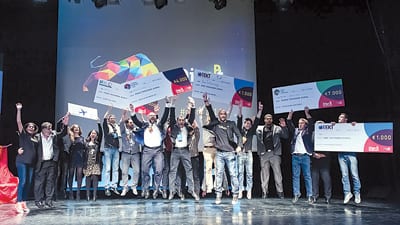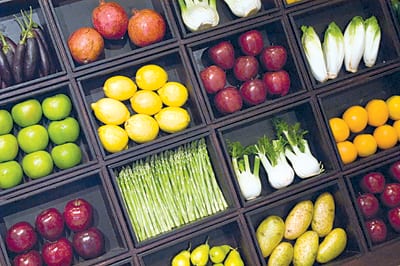Novi Sad: 84th International Agricultural Fair
 The Fair welcomed its first foreign exhibitors eighty years ago; namely, Bulgarians who had come to present their poultry; 60 years ago, in 1957, it became recognised as an international and common Yugoslav fair. There has been a marked increase in the number of foreign exhibitors over the last several years, which reaffirms the fact that the most significant event of the Novi Sad Fair and the biggest agricultural business happening in this part of Europe is a place where supply and demand, as well as domestic and foreign companies, meet.
The Fair welcomed its first foreign exhibitors eighty years ago; namely, Bulgarians who had come to present their poultry; 60 years ago, in 1957, it became recognised as an international and common Yugoslav fair. There has been a marked increase in the number of foreign exhibitors over the last several years, which reaffirms the fact that the most significant event of the Novi Sad Fair and the biggest agricultural business happening in this part of Europe is a place where supply and demand, as well as domestic and foreign companies, meet.
Visitors will have the opportunity to attend the impressive Agricultural Machinery Exhibition, while preparations for the National Livestock Show and Organic Produce Exhibition are also underway.
International B2B meetings will facilitate cooperation between entrepreneurs and institutions from around the world. Novi Sad Fair’s Congress Centre, which boasts modern infrastructure, will be home to numerous promotions, presentations, professional gatherings and other business events. New segments and engaging visitor content are also planned.
The 84th International Agricultural Fair in Novi Sad will be held from 13th to 19th May 2017.
 Future Agro Challenge (FAC) is a global competition that discovers innovate fundable food and agribusiness startups from various corners of the globe addressing national, regional and global challenges. FAC provides key tools and opportunities to help them grow their business and expand them into new markets. FAC is working to make a difference on a global level by increasing interaction amongst agro innovators, entrepreneurs, and stakeholders by addressing national policies and challenges.
Future Agro Challenge (FAC) is a global competition that discovers innovate fundable food and agribusiness startups from various corners of the globe addressing national, regional and global challenges. FAC provides key tools and opportunities to help them grow their business and expand them into new markets. FAC is working to make a difference on a global level by increasing interaction amongst agro innovators, entrepreneurs, and stakeholders by addressing national policies and challenges.• To encourage technology and methodology incorporating Evergreen Practices (to increase food production and efficiency in a sustainable manner, reducing greenhouse gases and carbon and water footprints)
• To upgrade agricultural education and training
• To revolutionise the approach to a healthy lifestyle and nutrition
• To promote business and investment opportunities in agribusiness
• To grow a global community of experts, investors, and innovators
The Future Agro Challenge (FAC) began as an initiative of Industry Disruptors-Game Changers (ID-GC), a non-profit/non-governmental organisation that hosts Disrupt Startup ScaleUp in Athens aiming to create an ecosystem that fosters and promotes innovative entrepreneurship.
Source futureagrochallenge.com
Smart Eco-Social Villages For Rural Development
 To encourage ways of boosting rural development, the European Commission has launched a call for tender for a pilot project on smart eco-social villages.What are the characteristics, drivers and factors of success for smart ecosocial villages? How do we work towards achieving villages with a viable economy, attractive living conditions and that are environmentally sustainable, with access to technology and state-of-the-art connectivity that could help boost rural areas.
To encourage ways of boosting rural development, the European Commission has launched a call for tender for a pilot project on smart eco-social villages.What are the characteristics, drivers and factors of success for smart ecosocial villages? How do we work towards achieving villages with a viable economy, attractive living conditions and that are environmentally sustainable, with access to technology and state-of-the-art connectivity that could help boost rural areas.Organic Market In Europe
 The organic market in Europe continues to grow. In 2015, it increased by 13% and nearly reached €30 billion. At BIOFACH, the world’s leading trade fair for organic food, the Research Institute of Organic Agriculture FiBL and the Agricultural Market Information Company AMI presented the 2015 data of the European organic sector in February 2017.
The organic market in Europe continues to grow. In 2015, it increased by 13% and nearly reached €30 billion. At BIOFACH, the world’s leading trade fair for organic food, the Research Institute of Organic Agriculture FiBL and the Agricultural Market Information Company AMI presented the 2015 data of the European organic sector in February 2017.Organic Sector In Serbia
 According to data of the Ministry of Agriculture and Environmental Protection (MAEP), and the Group for organic production that records the database on organic production, based on annual reports of authorised control organisations, organic production in the Republic of Serbia in 2015 recorded overall growth in surface in organic status, as well as in livestock numbers and numbers of producers. A surface area of 15.298 ha (including meadows and pastures) was cultivated, including areas undergoing conversion to organic status. In comparison to 2014 (9,547.8ha), the total area increased by 60.25% which is a high rise, while in five years the rise was 261.3%.
According to data of the Ministry of Agriculture and Environmental Protection (MAEP), and the Group for organic production that records the database on organic production, based on annual reports of authorised control organisations, organic production in the Republic of Serbia in 2015 recorded overall growth in surface in organic status, as well as in livestock numbers and numbers of producers. A surface area of 15.298 ha (including meadows and pastures) was cultivated, including areas undergoing conversion to organic status. In comparison to 2014 (9,547.8ha), the total area increased by 60.25% which is a high rise, while in five years the rise was 261.3%.The share of organic production in overall arable land in Serbia increased by 0.44%. Total arable land utilised for organic production in 2015 (meadows and pastures excluded), was 13,398 ha, and 67.53% more than in 2014, when we had 7,998.5 ha under organic production.This area does not include land used for harvesting wild berries, mushrooms and herbs. It should be noted that there is no official methodology in Serbia to obtain data on the total area for wild collection and harvesting wild plant species from their natural habitats.The share of utilised land under organic production in total agricultural land in 2015 was 0.44% which is 0.16% more than in 2014.Source: National Association Serbia Organica
Decline In Export Of Serbian Raspberries
 In the last few months, Serbia has been recording a constant decline in export of raspberry compared to previous years, while cold storage units in Western Serbia have huge quantities of frozen raspberry on a stock.The interest shown in Serbian raspberries abroad has been at its lowest in the last ten years – the exporters claim. They also say that the purchase price of frozen raspberry is lower than the price of fresh ones, which was in the region of around 230 dinars per kilo.Last year, this fruit was sold for upwards of 320 dinars per kilo. Exporters say that the reason for that is the fact that Poland had a record-breaking year in 2016 when it comes to raspberry yield.
In the last few months, Serbia has been recording a constant decline in export of raspberry compared to previous years, while cold storage units in Western Serbia have huge quantities of frozen raspberry on a stock.The interest shown in Serbian raspberries abroad has been at its lowest in the last ten years – the exporters claim. They also say that the purchase price of frozen raspberry is lower than the price of fresh ones, which was in the region of around 230 dinars per kilo.Last year, this fruit was sold for upwards of 320 dinars per kilo. Exporters say that the reason for that is the fact that Poland had a record-breaking year in 2016 when it comes to raspberry yield.Cattle Trade Remains Steady
 The cattle trade remains steady for the week ending April 7th on the back of steady demand with some recovery in supplies.In the UK, the trade has seen a slight uplift on the back of ease in supplies. Cattle prices from the AHDB remain stable in sterling terms and the GB R4L grade steers were averaging at 418.81 cent/kg for the week ending 1st April. In terms of heifer prices, the R3 heifer in Great Britain was making the equivalent of 411 cents/kg with the Northern Ireland price making on average 406 cents/kg.
The cattle trade remains steady for the week ending April 7th on the back of steady demand with some recovery in supplies.In the UK, the trade has seen a slight uplift on the back of ease in supplies. Cattle prices from the AHDB remain stable in sterling terms and the GB R4L grade steers were averaging at 418.81 cent/kg for the week ending 1st April. In terms of heifer prices, the R3 heifer in Great Britain was making the equivalent of 411 cents/kg with the Northern Ireland price making on average 406 cents/kg.